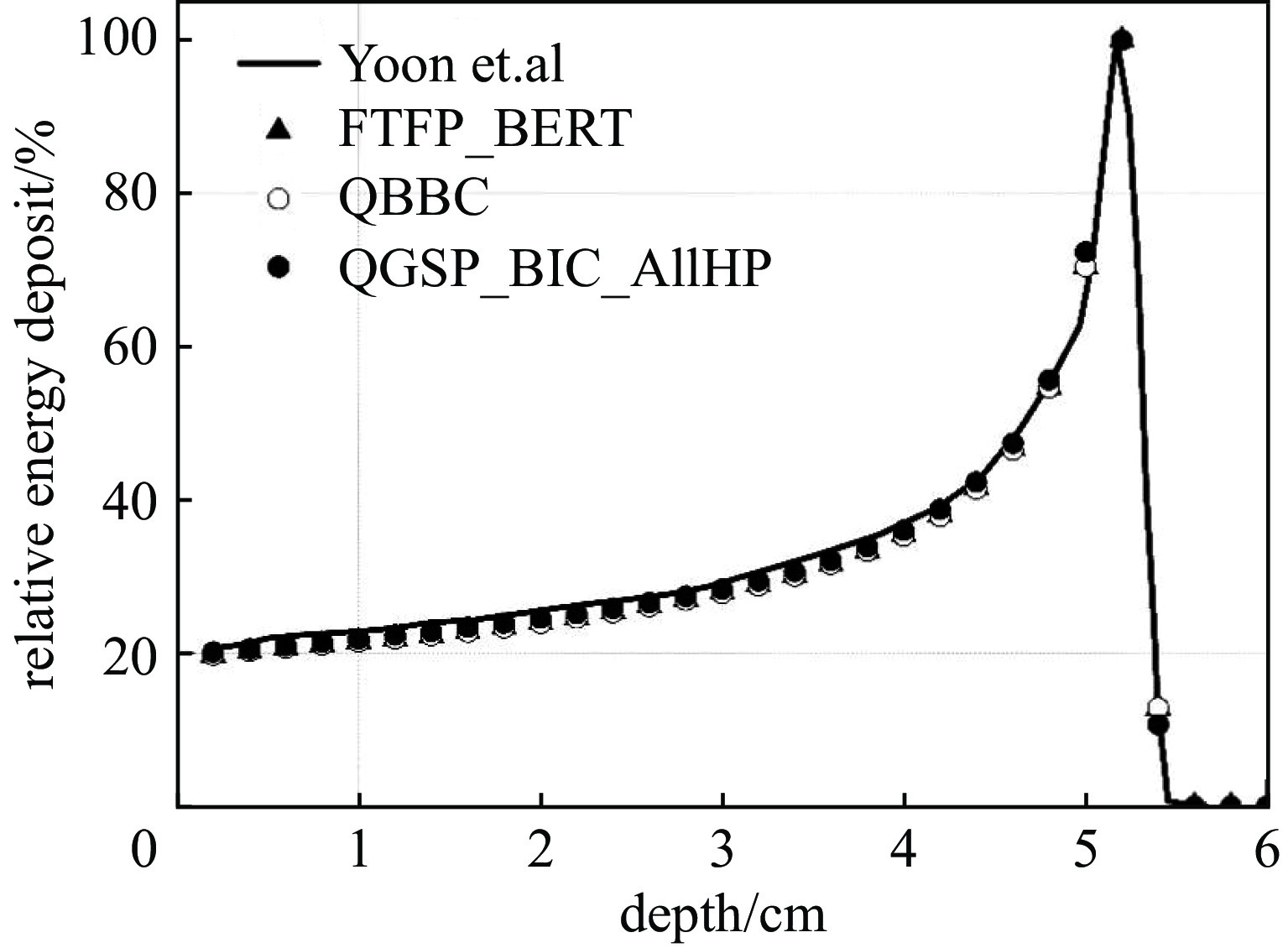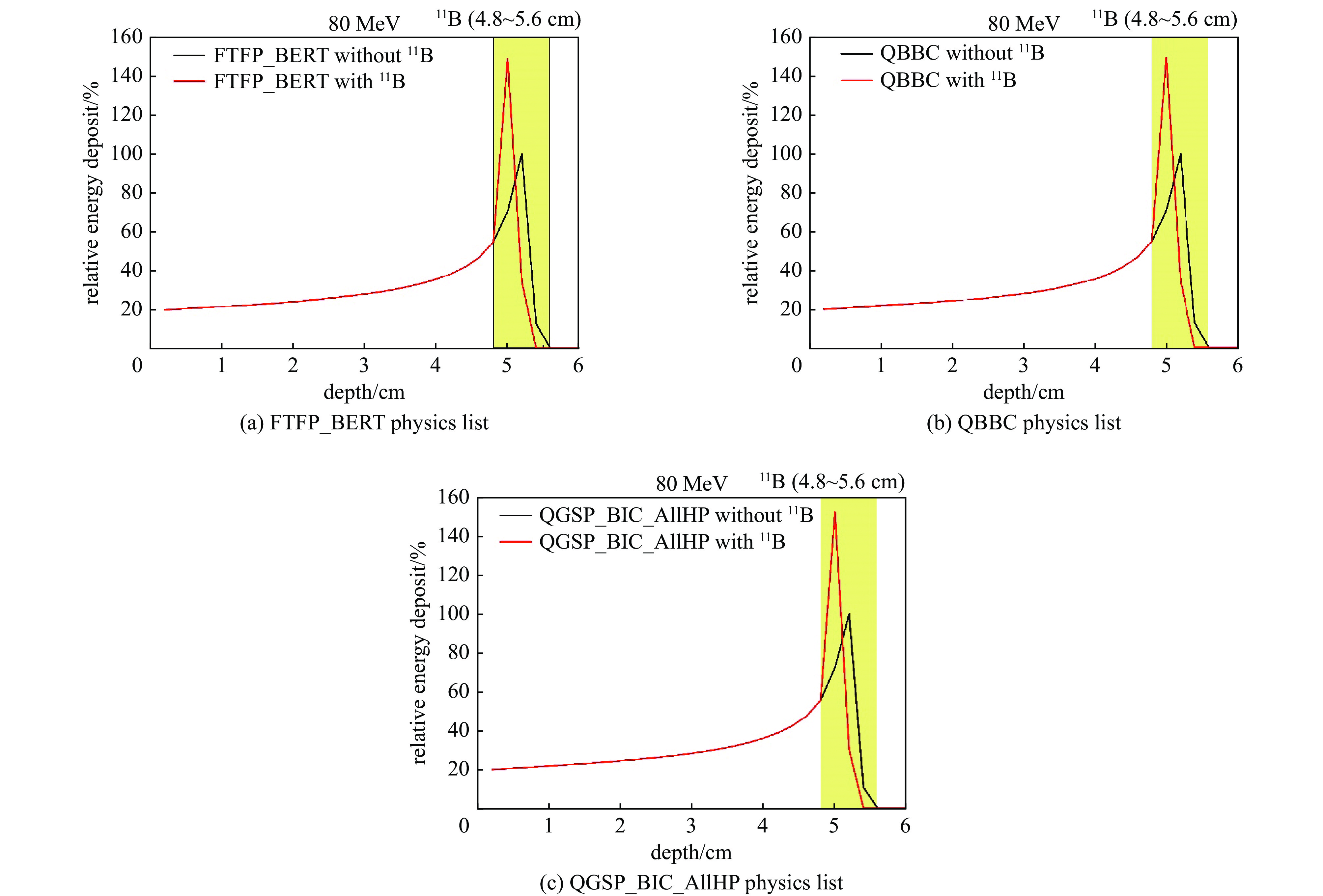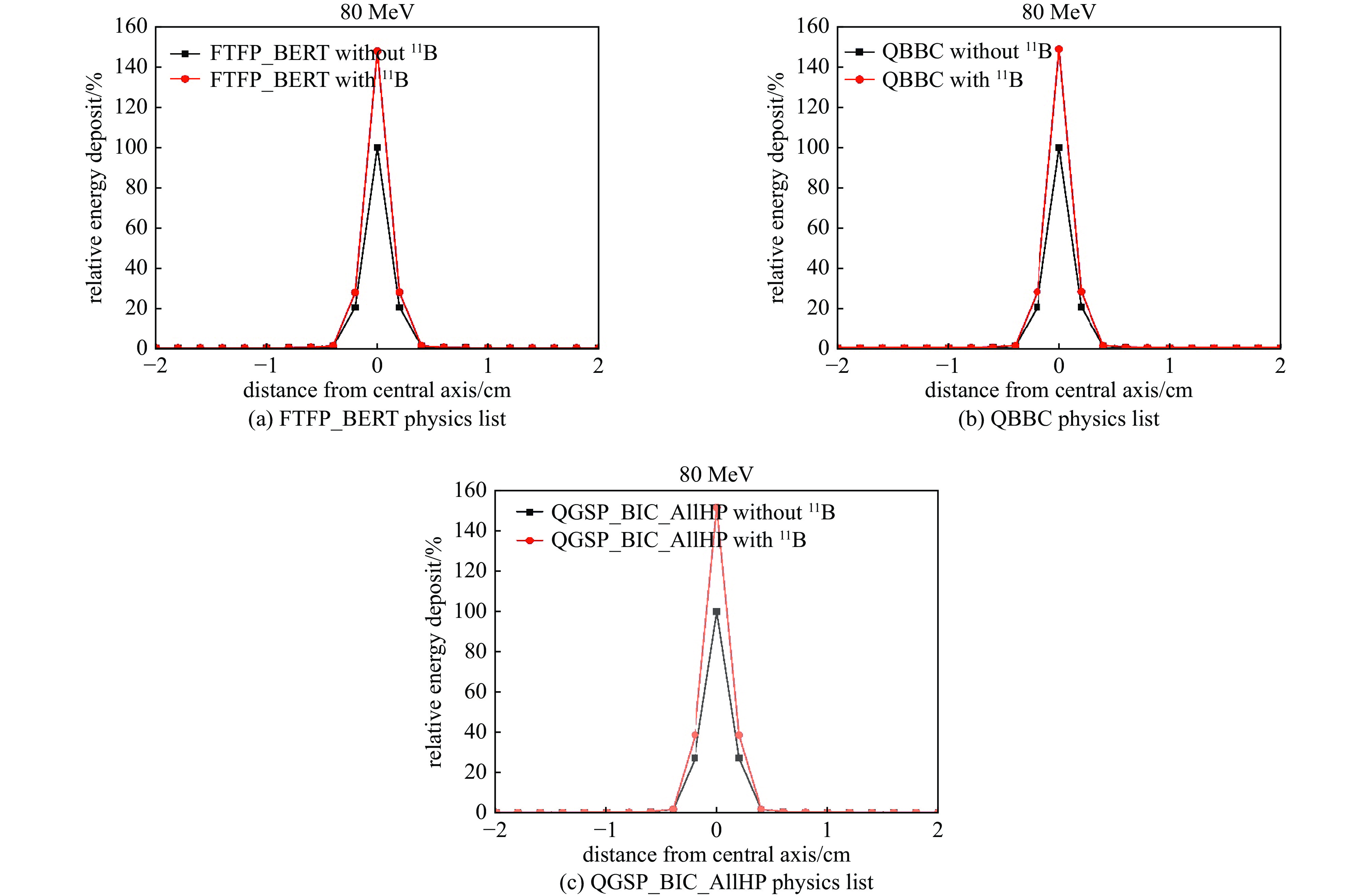Effect of different physics lists in Monte Carlo simulation of proton boron capture therapy
-
摘要: 比较了蒙特卡罗(MC)软件Geant4中不同物理过程对质子硼俘获治疗(PBCT)的剂量学影响。选取Geant4中FTFP、QBBC和QGSP三种物理过程,构建包含质子硼核反应的质子剂量沉积的模型,比较了80 MeV质子束选取三种物理过程在有无硼时的剂量分布,以及3 MeV质子束轰击纯硼时的核反应产物数据。三种物理过程在有无硼时水模体中的剂量分布无显著差异,一致性较好。FTFP物理过程获得的质子硼核反应产物与QBBC和QGSP物理过程相比差异较大。而QGSP物理过程得到的α粒子的产额、平均能量和能量范围与QBBC物理过程相比与实际情况吻合更好。综合评估三种物理过程中使用的非弹性散射模型以及模拟得到的核反应产物数据,Geant4中的QGSP物理过程更适用于PBCT的MC模拟研究。Abstract: To compare the effects of different physics lists on the dose of proton boron capture therapy (PBCT) by Monte Carlo simulation Geant4. Geant4 was used to establish PBCT model with different three physics lists (FTFP, QBBC and QGSP). Compared the dose distribution of three physics lists with and without boron using an 80 MeV proton beam, as well as the nuclear reaction product data of a 3 MeV proton beam bombards pure boron. There is no significant difference in the dose distribution of the three physics lists in the water phantom with and without boron, and the consistency of the different physics models PDD’s curves are good. The PBCT nuclear reaction products obtained from FTFP physics list are significantly less than those obtained from QBBC and QGSP physics lists. The yields, mean energies and energy ranges of the alpha particles obtained from the QGSP physics list are more consistent with the actual situation than that of the QBBC physics list. The QGSP physics list in Geant4 is more suitable for MC simulation studies of PBCT, after a comprehensive evaluation of the inelastic scattering models used by the three physics lists and the simulated nuclear reaction data.
-
Key words:
- proton boron capture therapy /
- Monte Carlo /
- Geant4 /
- dosimetry /
- nuclear reaction products
-
表 1 模拟中的材料组成
Table 1. Composition of material in MC
material wB/% wH/% wO/% wC/% wN/% wAr/% density/(g·cm−3) boron 100 − − − − − 2.08 water − 11.19 88.81 − − − 1 air − − 23.18 0.02 75.52 1.28 1.205×10−3 vacuum − − − − − − 1.0×10−25 表 2 三种物理过程中的物理模型及反应截面
Table 2. Physics models and reaction cross-section of three physics lists
physics lists type of modules models (particle and energy ranges) cross-sections FTFP_BERT hadron physics inelastic model Fritiof parton (FTF)
(p,n, 3 GeV~100 TeV)p (G4BGGNucleonInelasticXS)
n (G4NeutronInelasticXS)Bertini intranuclear cascade
(p,n, 0~6 GeV)elastic model G4ChipsElasticModel
(p,n, 0~100 TeV)p (G4BGGNucleonElasticXS)
n (G4NeutronElasticXS)electromagnetic physics G4EmStandardPhysics(γ,e−) − QBBC hadron physics inelastic model Fritiof parton (FTF)
(p,n, 3 GeV~100 TeV)p (G4ParticleInelasticXS)
n (G4NeutronInelasticXS)Binary cascade
(p,n, 0~1.5 GeV)Bertini (p,n, 1~6 GeV) elastic model G4ChipsElasticModel
(p,n, 0~100 TeV)p (G4BGGNucleonElasticXS)
n (G4NeutronElasticXS)electromagnetic physics G4EmStandardPhysics(γ,e−) − QGSP_BIC_AllHP hadron physics inelastic model Binary cascade
(p,n, 0~6 GeV)p ≥20 MeV(G4BGGNucleonInelasticXS)
n (G4NeutronInelasticXS)Quark-gluon String (QGS)
(p,n, >12 GeV)Fritiof parton (FTF)
(p,n, 3~25 GeV)elastic model G4ChipsElasticModel
(p,n, 0~100 TeV)p (G4BGGNucleonElasticXS)
n (G4NeutronElasticXS)electromagnetic physics G4EmStandardPhysics4(γ,e−) − 表 3 三种物理过程的质子硼核反应数据
Table 3. Nuclear reaction product data of PBCT with three physics lists
energy/MeV physics list yields of α/% mean energy of α/MeV energy ranges of α//MeV 3 FTFP_BERT 0.1 4.51 0.11~9.16 QBBC 7.6 4.17 0.35~9.23 QGSP_BIC_AllHP 3.2 5.59 0.01~9.58 -
[1] Mohan R, Grosshans D. Proton therapy-Present and future[J]. Advanced Drug Delivery Reviews, 2017, 109: 26-44. doi: 10.1016/j.addr.2016.11.006 [2] Yan Susu, Ngoma T A, Ngwa W, et al. Global democratisation of proton radiotherapy[J]. The Lancet Oncology, 2023, 24(6): e245-e254. doi: 10.1016/S1470-2045(23)00184-5 [3] Lomax A J, Bortfeld T, Goitein G, et al. A treatment planning inter-comparison of proton and intensity modulated photon radiotherapy[J]. Radiotherapy and Oncology, 1999, 51(3): 257-271. doi: 10.1016/S0167-8140(99)00036-5 [4] Stuschke M, Kaiser A, Abu-Jawad J, et al. Re-irradiation of recurrent head and neck carcinomas: comparison of robust intensity modulated proton therapy treatment plans with helical tomotherapy[J]. Radiation Oncology, 2013, 8: 93. doi: 10.1186/1748-717X-8-93 [5] Kandula S, Zhu Xiaorong, Garden A S, et al. Spot-scanning beam proton therapy vs intensity-modulated radiation therapy for ipsilateral head and neck malignancies: a treatment planning comparison[J]. Medical Dosimetry, 2013, 38(4): 390-394. doi: 10.1016/j.meddos.2013.05.001 [6] Early Breast Cancer Trialists' Collaborative Group (EBCTCG). Effect of radiotherapy after breast-conserving surgery on 10-year recurrence and 15-year breast cancer death: meta-analysis of individual patient data for 10 801 women in 17 randomised trials[J]. The Lancet, 2011, 378(9804): 1707-1716. doi: 10.1016/S0140-6736(11)61629-2 [7] Partridge M, Ramos M, Sardaro A, et al. Dose escalation for non-small cell lung cancer: analysis and modelling of published literature[J]. Radiotherapy and Oncology, 2011, 99(1): 6-11. doi: 10.1016/j.radonc.2011.02.014 [8] Deville C Jr, Jain A, Hwang W T, et al. Initial report of the genitourinary and gastrointestinal toxicity of post-prostatectomy proton therapy for prostate cancer patients undergoing adjuvant or salvage radiotherapy[J]. Acta Oncologica, 2018, 57(11): 1506-1514. doi: 10.1080/0284186X.2018.1487583 [9] Leroy R, Benahmed N, Hulstaert F, et al. Proton therapy in children: a systematic review of clinical effectiveness in 15 pediatric cancers[J]. International Journal of Radiation Oncology Biology Physics, 2016, 95(1): 267-278. doi: 10.1016/j.ijrobp.2015.10.025 [10] Karger C P, Peschke P. RBE and related modeling in carbon-ion therapy[J]. Physics in Medicine & Biology, 2018, 63: 01TR02. [11] Mein S, Klein C, Kopp B, et al. Assessment of RBE-weighted dose models for carbon ion therapy toward modernization of clinical practice at HIT: in vitro, in vivo, and in patients[J]. International Journal of Radiation Oncology Biology Physics, 2020, 108(3): 779-791. [12] Rackwitz T, Debus J. Clinical applications of proton and carbon ion therapy[J]. Seminars in Oncology, 2019, 46(3): 226-232. doi: 10.1053/j.seminoncol.2019.07.005 [13] Li Yue, Li Xiaoman, Yang Jiancheng, et al. Flourish of proton and carbon ion radiotherapy in China[J]. Frontiers in Oncology, 2022, 12: 819905. doi: 10.3389/fonc.2022.819905 [14] Paganetti H, Beltran C, Both S, et al. Roadmap: proton therapy physics and biology[J]. Physics in Medicine & Biology, 2021, 66: 05RM01. [15] Cao Wenhua, Khabazian A, Yepes P P, et al. Linear energy transfer incorporated intensity modulated proton therapy optimization[J]. Physics in Medicine & Biology, 2018, 63: 015013. [16] Bai Xuemin, Lim G, Wieser H P, et al. Robust optimization to reduce the impact of biological effect variation from physical uncertainties in intensity-modulated proton therapy[J]. Physics in Medicine & Biology, 2019, 64: 025004. [17] Yoon D K, Jung J, Suh T S. Application of proton boron fusion reaction to radiation therapy: a Monte Carlo simulation study[J]. Applied Physics Letters, 2014, 105: 223507. doi: 10.1063/1.4903345 [18] Jung J Y, Yoon D K, Barraclough B, et al. Comparison between proton boron fusion therapy (PBFT) and boron neutron capture therapy (BNCT): a Monte Carlo study[J]. Oncotarget, 2017, 8(24): 39774-39781. doi: 10.18632/oncotarget.15700 [19] Jung J Y, Yoon D K, Lee H C, et al. The investigation of physical conditions of boron uptake region in proton boron fusion therapy (PBFT)[J]. AIP Advances, 2016, 6: 095119. doi: 10.1063/1.4963741 [20] Meyer H J, Titt U, Mohan R. Technical note: Monte Carlo study of the mechanism of proton-boron fusion therapy[J]. Medical Physics, 2022, 49(1): 579-582. doi: 10.1002/mp.15381 [21] Martinez-Val J M, Eliezer S, Piera M, et al. Fusion burning waves in proton-boron-11 plasmas[J]. Physics Letters A, 1996, 216(1/5): 142-152. [22] Labaune C, Baccou C, Depierreux S, et al. Fusion reactions initiated by laser-accelerated particle beams in a laser-produced plasma[J]. Nature Communications, 2013, 4: 2506. doi: 10.1038/ncomms3506 [23] Sikora M H, Weller H R. A new evaluation of the 11B(p, α) αα reaction rates[J]. Journal of Fusion Energy, 2016, 35(3): 538-543. doi: 10.1007/s10894-016-0069-y [24] Moreau D C. Potentiality of the proton-boron fuel for controlled thermonuclear fusion[J]. Nuclear Fusion, 1977, 17(1): 13-20. doi: 10.1088/0029-5515/17/1/002 [25] Wang L, Chui C S, Lovelock M. A patient-specific Monte Carlo dose-calculation method for photon beams[J]. Medical Physics, 1998, 25(6): 867-878. doi: 10.1118/1.598262 [26] Ottosson W, Sibolt P, Larsen C, et al. Monte Carlo calculations support organ sparing in Deep-Inspiration Breath-Hold intensity-modulated radiotherapy for locally advanced lung cancer[J]. Radiotherapy and Oncology, 2015, 117(1): 55-63. doi: 10.1016/j.radonc.2015.08.032 [27] Jarlskog C Z, Paganetti H. Physics settings for using the Geant4 toolkit in proton therapy[J]. IEEE Transactions on Nuclear Science, 2008, 55(3): 1018-1025. doi: 10.1109/TNS.2008.922816 [28] Folger G, Ivanchenko V N, Wellisch J P. The binary cascade: nucleon nuclear reactions[J]. The European Physical Journal A - Hadrons and Nuclei, 2004, 21(3): 407-417. [29] Serber R. Nuclear reactions at high energies[J]. Physical Review, 1947, 72(11): 1114-1115. doi: 10.1103/PhysRev.72.1114 [30] Tran N H, Shtam T, Marchenko Y Y, et al. Current state and prospectives for proton boron capture therapy[J]. Biomedicines, 2023, 11: 1727. doi: 10.3390/biomedicines11061727 [31] Tabbakh F, Hosmane N S. Enhancement of radiation effectiveness in proton therapy: comparison between fusion and fission methods and further approaches[J]. Scientific Reports, 2020, 10: 5466. doi: 10.1038/s41598-020-62268-5 [32] Liu Dong, Lee S L, Woo J K. Evaluation of proton-boron fusion-enhanced proton therapy (PBFEPT) by using a simulation method[J]. New Physics:Sae Mulli, 2019, 69(2): 215-220. doi: 10.3938/NPSM.69.215 [33] Enger S A, Giusti V, Arce P. SU-E-T-492: high precision cross sections and physics models for proton interactions below 20 MeV in Geant4[J]. Medical Physics, 2013, 40(6): 319. [34] Lu Yu, Xu Zhao, Zhang Lianxin, et al. GEANT4 simulations of the neutron beam characteristics for 9Be/7Li targets bombarded by the low energy protons[J]. Nuclear Instruments and Methods in Physics Research Section B:Beam Interactions with Materials and Atoms, 2021, 506: 8-14. [35] Mazzone A, Finocchiaro P, Lo Meo S, et al. On the (un)effectiveness of proton boron capture in proton therapy[J]. The European Physical Journal Plus, 2019, 134: 361. doi: 10.1140/epjp/i2019-12725-8 -

 点击查看大图
点击查看大图
计量
- 文章访问数: 43
- HTML全文浏览量: 17
- PDF下载量: 9
- 被引次数: 0




 下载:
下载:




